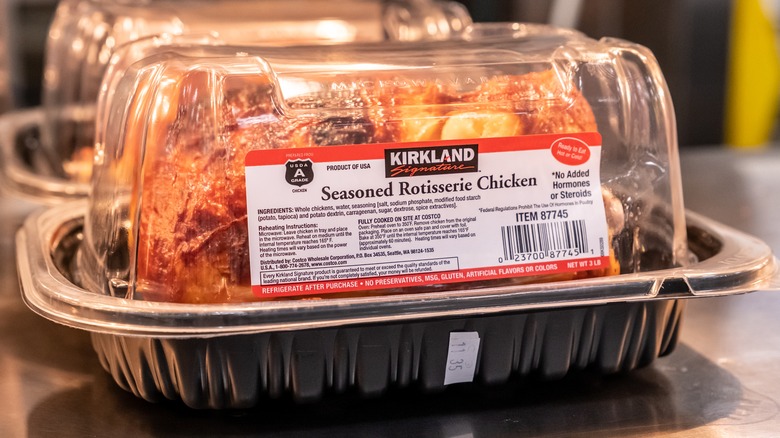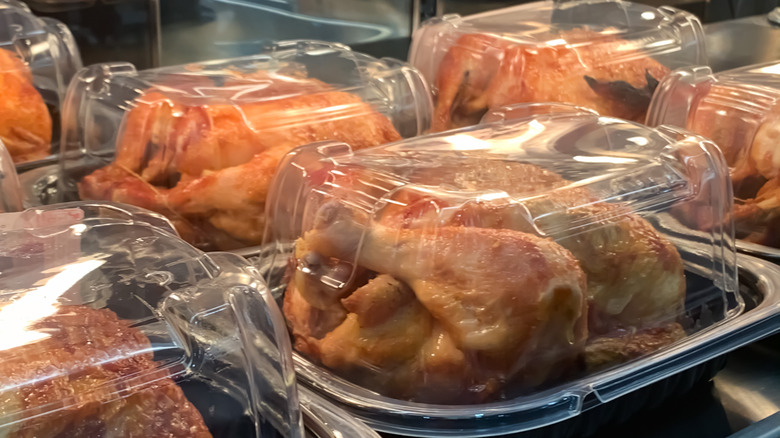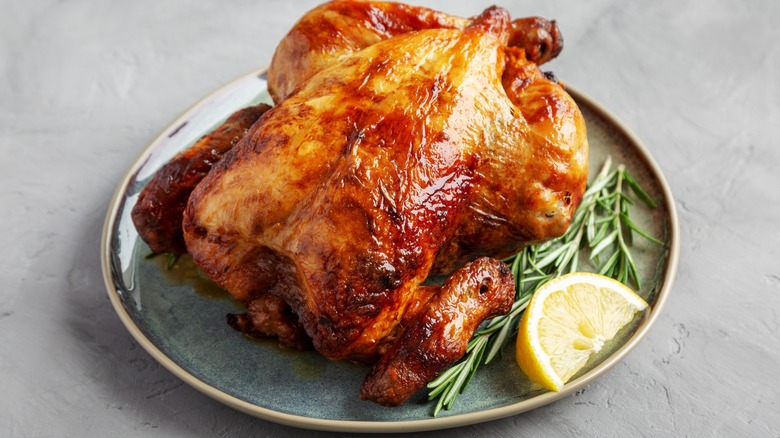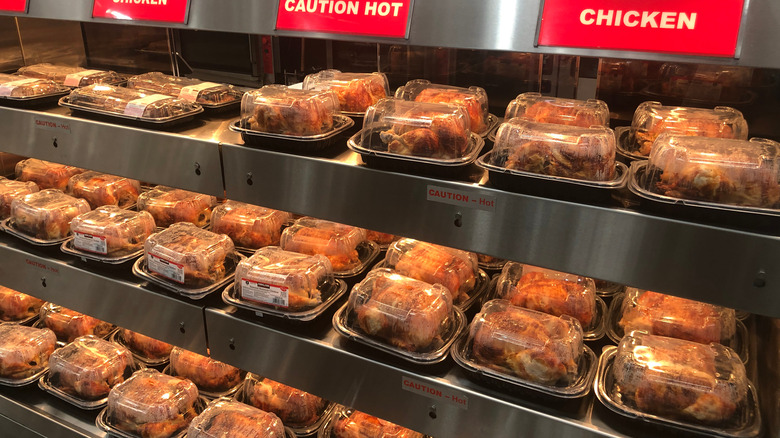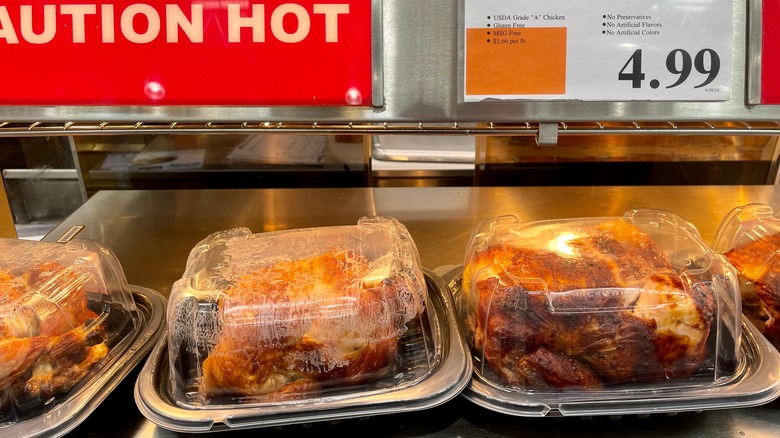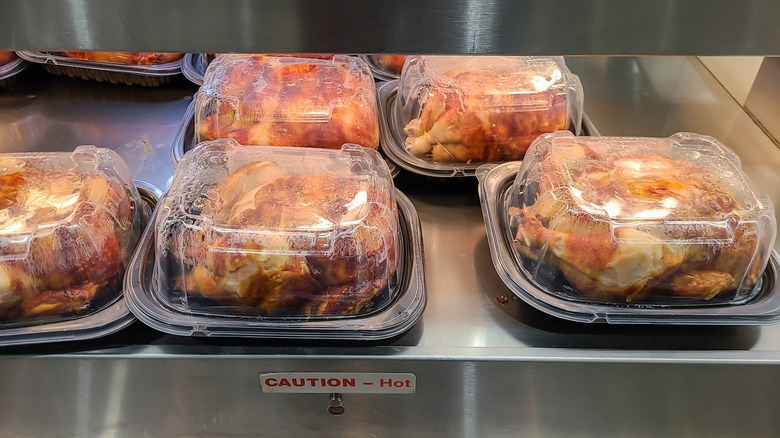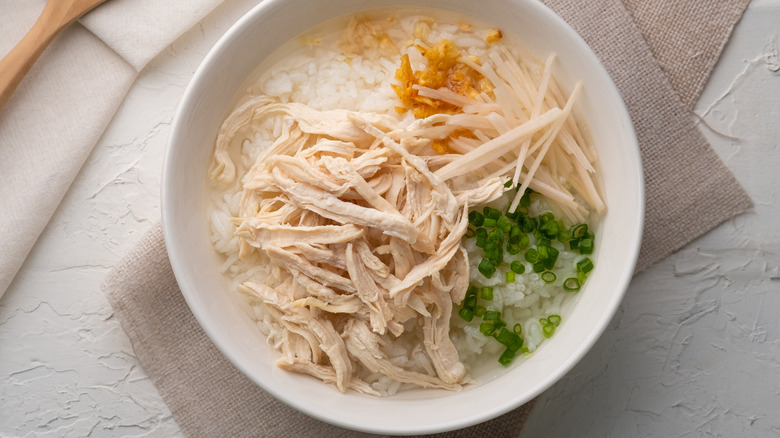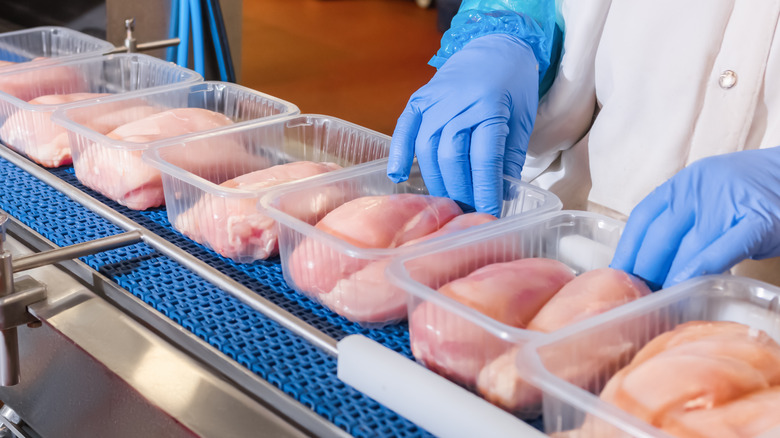8 Secrets Of The $4.99 Costco Rotisserie Chicken
Costco is nothing if not consistent and reliable. A customer — or rather a member, because it's a club-style store that charges an annual fee for the privilege of shopping — can expect the same experience whenever and wherever they decide to make a Costco run. They're going to face crowds as they head into a massive warehouse stocked from floor to ceiling with pallets of food sold in bulk and big-ticket items like appliances and lawn furniture as they make their way from the ID check at the front of the store to the enticing rotisserie chicken station located way in the back.
For many Costco customers, it's a foregone conclusion that they're going to pick up a hot, fresh, pre-seasoned and perfectly cooked chicken off a huge rack, often with a store employee tirelessly packaging more. The pleasant aroma is undeniably attractive, but not as much as the price: A Costco rotisserie chicken invariably costs an unbelievable $4.99 — always.
Those cheap but not cheaply made chickens have formed the basis of hundreds of millions of dinners over the decades. The under-five-dollar Costco chicken roasted on a spit is an iconic part of American cuisine — here's why, and how, that came to pass. Enjoy a big, juicy slice of trivia about the Costco rotisserie chicken on us.
What is in a Costco rotisserie chicken?
Costco's rotisserie chicken is a versatile and simple food, but maybe not quite as simple as it may seem. It consists of little more than a chicken, a saline solution, and some marinade elements, making for a grand total of 11 items on its ingredients list on the product label. After chicken and water comes salt, sodium phosphate, potato starch, tapioca starch, potato dextrin, carrageenan, sugar, dextrose, and "spice extractives." The salt level in that chicken is relatively high, with a three-ounce serving packing 460 milligrams, or 20% of the recommended daily intake. Most of those ingredients are generally regarded as safe. Carrageenan is a thickening agent derived from seaweed, and casein is a dairy-based protein. Sodium phosphate, however, has been cited as an agent that could lead to kidney and bowel problems.
The Costco rotisserie chicken is as notable for what it isn't made with as much as what it does include. According to the label, it's free of potentially problematic ingredients like MSG, hormones, artificially-derived colors and flavors, and gluten.
How big is a Costco rotisserie chicken?
While not every single one of the millions of Costco rotisserie chickens cooked, sold, and consumed each year weigh exactly the same, the production standards in place make for a product that weighs right around three pounds. Even considering the water and liquids used and the inedible or unusable portions like bones and gristle, a Costco rotisserie chicken is still almost entirely meat; one customer got 2.8 pounds of meat out of a typical bird.
This makes a Costco rotisserie chicken a very good deal as far as price-per-pound is concerned. At a pre-tax cost of $4.99, that works out to about $1.78 per pound of chicken. According to the USDA's National Monthly Pasture Raised Poultry Report for February 2023, a whole chicken actually costs more than a Costco chicken, at $5.49. For less money than that, Costco members get a chicken that's already cooked and ready to eat.
Costco sells a lot of rotisseries chickens
According to The Hustle, more than nine billion chickens are consumed in the U.S. each year, and a sizable percentage of those are bought from the hot rack in the back of a Costco. CNBC reports that Costco can process more than 100 million chickens in the United States each year, which it then sells at a brisk pace to its members at the cut-rate price of $4.99 each.
As of March 2023, Costco operates 585 warehouse-style stores across 48 American states and territories. They sell a total of around 106 million birds a year, which breaks down to an average of about 181,200 chickens per each individual U.S. Costco outlet. Chain-wide, Costco is open 358 days a year (it's closed on a handful of holidays), meaning any given store sells around 506 chickens every single day. It goes without saying that the rotisserie chicken one of Costco's single most popular items across the entire company.
Why Costco rotisserie chicken is so cheap
As of 2023, a Costco rotisserie chicken costs $4.99, just like it has for more than two decades, despite rising food costs and general inflation. (After national economic woes in 2008, Costco raised the price to $5.99, and then lowered it back to $4.99 less than a year later.) It's not like Costco is even making money on the more than 100 million rotisserie chickens it sells each year. In an earnings call in 2015, chief financial officer Richard Galanti told investors that the company technically loses money on the pre-cooked chickens, somewhere in the neighborhood of $30 to $40 million a year.
That's all part of Costco's profit-earning strategy. The chickens being priced so famously and familiarly low is a form of marketing. It gets customers into the store, and then, once there, the theory and sales data suggest, they buy lots more stuff — and Costco, a bulk warehouse store, doesn't offer that many small or inexpensive items. The term for this is a "loss leader" — Costco suffers a loss in profits but it triggers more profits through other purchases. That's also why the metal racks bursting with hot chickens fresh out of the oven are located at the back. To get to the chickens, customers walk all the way through the store, and then all the way back up to the registers, making for two opportunities to pick up other items that catch their eye.
When are Costco rotisserie chickens ready?
Because every Costco sells so many rotisserie chickens, staff members in the store's kitchen work throughout the day to cook, package, and set out the items for sale in order to meet the constant demand. Attempts are made to ensure that there are always at least a few on display for quick and easy purchase, but some customers prefer a fresh bird as opposed to one that came out of the oven an hour or two earlier.
All that preparation means a Costco is almost always going to smell like just-cooked chicken, so the aroma isn't an effective method to know just when the rotisserie chickens are at their hottest, juiciest, and freshest. According to The Krazy Coupon Lady and Yelp!, some stores may have time targets for when the first batches emerge each day. A Costco employee told The U.S. Sun that customers hunting for fowl should perk up their ears — staff will apparently briefly ring a bell when a new run of rotisserie chickens are ready to go.
Costco rotisserie chickens are great for meal prep
The ready-made, rotisserie-style chicken is one of the most popular and ubiquitous convenience foods in the United States. Americans buy 900 million whole, spit-roasted chickens each year, and 12% of those come from Costco. That makes for an astronomical number of meals, but not everyone is just serving that chicken as is, slicing up the breast and pulling off the drumsticks. Even Costco itself takes unsold rotisserie chickens, shreds the usable meat, and sells them in big plastic tubs. Seasoned and cooked shredded chicken, either straight from Costco or out of the refrigerator a day later, is an extraordinarily useful ingredient, an ideal addition or base in a variety of recipes.
This kind of chicken can be used in place of pork in a saucy, barbecue-style classic, like pulled chicken. It could also serve as the protein in restaurant-style chicken taquitos, or an apple chicken salad, a ramen-inspired cold noodle salad, or in literally any other dish that calls for simple, basic, cooked chicken.
Not everyone appreciates the Costco rotisserie chicken
In "Dave Chang Goes to Costco and Unraveling the Truffle Conundrum," a January 2023 installment of "The Dave Chang Show," the Momofuku chef, restaurateur, and TV personality positioned himself as perhaps the food world's most prominent and influential rotisserie chicken detractor. He isn't a fan of Costco's, specifically, which he picked up after waiting in a very long line with other customers on his second-ever trip to the warehouse store.
"I think the Costco chicken is the worst rotisserie chicken," Chang said (via People). "They're not good. They're not seasoned." That latter criticism is especially pointed in regards to eating the chicken the day after purchase, which many customers must do, using the meat in recipes. "The reason why it's important to have it properly seasoned is, you might eat it the next day cold, and it's got to taste good cold." Chang made a final, emphatic conclusion about a day-old Costco rotisserie chicken: "It's inedible."
Costco runs its own chicken production facility
The following entry mentions alleged animal cruelty.
Costco may take a hit on every rotisserie chicken it sells, but it can limit the damage by tightly controlling every aspect (and cost) of the production process. In 2019, Costco created its own sprawling chicken production facility in Fremont, Nebraska, including a chicken feed mill, hatchery, and slaughter plants. The chickens themselves are grown to proper size via a network of contracted poultry farmers which provide Costco with the 100 million-plus animals it needs to maintain supply for the tremendous demand for rotisserie chickens. The processing plant operation reportedly cost Costco $450 million. However, by keeping everything virtually in-house, Costco is said to save 35 cents on every chicken, which adds up to annual cost-cutting measures worth around $35 million.
Just two years after the plant opened, it faced high-profile scrutiny and a lawsuit. In 2021, animal rights group Mercy for Animals secretly sent representatives to observe pre-slaughter chickens. Among their findings: Chickens with open wounds, surrounded in their own waste, and unable to walk. That prompted a Change.org petition urging Costco to change its poultry industrial practices and to "stop supporting animal cruelty." And then, alleging that Costco didn't change much if anything in light of the scandal, a group called Legal Impact for Chickens filed a lawsuit against Costco in June 2022. They allege that Costco violated animal welfare and anti-cruelty laws in Nebraska and Iowa, where some of its chicken processing also takes place.
